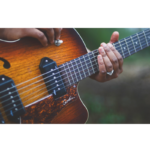Hey there, guitarist! 🎸
If you’ve ever played a guitar solo or learned a classic riff, chances are you’ve already touched on the pentatonic scale. It’s the backbone of countless iconic songs and solos, making it one of the most essential tools in a guitarist’s arsenal.
In this post, we’ll dive into pentatonic notes, explore their magic, and guide you through three effective practice routines to master them. Plus, I’ll show you how FretDeck’s Pentatonic Secrets Course can take your skills to the next level. Let’s rock!
What Are Pentatonic Notes?
The pentatonic scale is a five-note scale that’s incredibly versatile and sounds amazing over almost anything. It comes in two flavors:
- Major Pentatonic Scale: Happy, melodic tones (used in country, pop, and folk).
- Minor Pentatonic Scale: Gritty, soulful tones (perfect for rock, blues, and metal).
For example, the A minor pentatonic scale consists of these notes: A, C, D, E, and G. These five notes create a world of possibilities, from smooth melodic lines to blistering solos.

Download The FretDeck & Pentatonic Secrets Course!
Download Our Course
3 Practice Routines to Master Pentatonic Notes
If you want to turn the pentatonic scale into your musical superpower, consistent and creative practice is key. Here are three routines designed to help you nail those pentatonic notes and apply them in real musical settings.
1. The Box Breaker Exercise
The pentatonic scale is often taught using “box shapes” on the fretboard. While these are helpful, many players get stuck in one box. This exercise will help you break free.
Steps:
- Start with the first position of the A minor pentatonic scale (5th fret). Play it ascending and descending.
- Shift to the second position and connect it to the first.
- Continue linking all five positions up the fretboard.
- Reverse the process, descending through the positions.
Goal: Connect the pentatonic notes across the entire fretboard instead of staying locked in one position.
Tip: FretDeck’s Pentatonic Secrets Course includes visual diagrams and exercises to help you seamlessly move between these positions.
2. Rhythm and Timing Mastery
It’s not just the notes you play—it’s how you play them. This exercise focuses on using pentatonic notes with rhythmic variation to improve your timing and phrasing.
Steps:
- Set a metronome to 60 BPM.
- Play the A minor pentatonic scale, using quarter notes for the first pass (1 note per beat).
- Repeat the scale, this time using eighth notes (2 notes per beat).
- Progress to triplets and sixteenth notes.
- Mix up the rhythms by improvising short phrases with different note durations.
Goal: Develop control over timing and make your pentatonic playing more dynamic.
Pro Tip: FretDeck’s backing tracks in the Pentatonic Secrets Course are perfect for practicing rhythmic variations in a musical context.
3. Pentatonic Creativity Prompts
Creativity comes from challenging yourself to think outside the box. These prompts will help you apply pentatonic notes in real-world playing situations.
Prompts:
- String Skip Melodies: Play the scale but skip one string with every note. This creates unique, unexpected sounds.
- Add Slides and Bends: Use slides, bends, and vibrato to bring out the expressiveness of the pentatonic notes.
- Start on a Different Note: Instead of starting with the root (A in A minor pentatonic), begin on another note in the scale (like C or D) to create a fresh melodic approach.
Goal: Make your pentatonic solos and riffs stand out by using creative phrasing techniques.
Inspiration: The Pentatonic Secrets Course from FretDeck is packed with exercises that encourage creative exploration of the pentatonic scale.
If you’re diving into pentatonic notes, you might also enjoy reading 5 Reasons to Master Major Guitar Scales. It’s a great way to expand your musical foundation and see how pentatonic scales fit into the bigger picture of guitar playing.
Why Mastering Pentatonic Notes Matters
The pentatonic scale isn’t just for solos—it’s a gateway to understanding the guitar fretboard, building melodies, and creating memorable riffs. Once you’ve mastered these five magical notes, you’ll find that they unlock a world of musical opportunities, from blues jams to arena rock solos.
Learn with FretDeck: Pentatonic Secrets Course
If you’re ready to take your pentatonic playing to the next level, FretDeck’s Pentatonic Secrets Course is the ultimate guide. With step-by-step lessons, interactive exercises, and professional backing tracks, this course is designed to make mastering pentatonic notes fun and achievable.
What you’ll get:
- Detailed diagrams for all pentatonic positions
- Creative prompts and exercises to keep practice fresh
- Jam tracks to apply your skills in a musical setting
Join the Guitar Freaks Hangout on Discord
Want to share your progress, ask questions, or jam with fellow guitarists? Join our Guitar Freaks Hangout on Discord! It’s a friendly community of players who are passionate about learning and sharing their love for the guitar.
Which of these practice routines will you try first? Drop a comment below, and let’s chat about your pentatonic journey! Don’t forget to check out the Pentatonic Secrets Course to fast-track your mastery of pentatonic notes.

Download The FretDeck & Pentatonic Secrets Course!
Download Our Course










